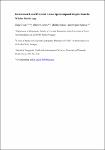Recreational Use of Protected Areas: Spatiotemporal Insights from the Wikiloc Mobile App
| dc.contributor.author | Costa, J | |
| dc.contributor.author | Gomes, A | |
| dc.contributor.author | Stokes, M | |
| dc.contributor.author | Saraiva, M | |
| dc.date.accessioned | 2024-03-08T14:56:41Z | |
| dc.date.available | 2024-03-08T14:56:41Z | |
| dc.identifier.issn | 1747-7603 | |
| dc.identifier.uri | https://pearl.plymouth.ac.uk/handle/10026.1/22157 | |
| dc.description.abstract |
Managing the rising number of visitors to protected areas (PAs) without compromising their environmental goals is a critical challenge that requires a complete understanding of how and when visitors use these spaces. Georeferenced data from fitness-tracking apps can provide detailed information about the visitor’s spatiotemporal behaviour inside PAs, but its potential is still underexplored. This study uses georeferenced data, from Wikiloc, to analyse the visitors’ spatiotemporal behaviour in Alvão Natural Park, Portugal. Our findings show that: 52% of the visitors’ use is concentrated around the Fisgas de Ermelo Waterfall; photos’ hotspots coincide with the waterfalls and viewpoints facing them; 2% of the routes crossed a zone where recreational use is illegal; Spring (26%) and April (11%) receive the most visitors; 52% of routes are done on the weekends; 66% of visitors are inside the park during noon; start/end places are located near parking spaces; the most frequent times to start a route are between 08:00-13:00 hrs, ending between 13-18:00 hrs. A new method was developed to calculate daily visitor numbers without photo concentration bias. These results offer valuable insights that can aid in PAs' environmental and recreational use management by quickly providing detailed and low-cost visitor monitoring data. | |
| dc.publisher | Taylor and Francis Group | |
| dc.title | Recreational Use of Protected Areas: Spatiotemporal Insights from the Wikiloc Mobile App | |
| dc.type | Journal Article | |
| plymouth.journal | Current Issues in Tourism | |
| dc.identifier.doi | 10.1080/13683500.2024.2329278 | |
| plymouth.organisational-group | |Plymouth | |
| plymouth.organisational-group | |Plymouth|Research Groups | |
| plymouth.organisational-group | |Plymouth|Faculty of Science and Engineering | |
| plymouth.organisational-group | |Plymouth|Faculty of Science and Engineering|School of Geography, Earth and Environmental Sciences | |
| plymouth.organisational-group | |Plymouth|Research Groups|Marine Institute | |
| plymouth.organisational-group | |Plymouth|REF 2021 Researchers by UoA | |
| plymouth.organisational-group | |Plymouth|Users by role | |
| plymouth.organisational-group | |Plymouth|Users by role|Academics | |
| plymouth.organisational-group | |Plymouth|REF 2021 Researchers by UoA|UoA07 Earth Systems and Environmental Sciences | |
| plymouth.organisational-group | |Plymouth|REF 2029 Researchers by UoA | |
| plymouth.organisational-group | |Plymouth|REF 2029 Researchers by UoA|UoA07 Earth Systems and Environmental Sciences | |
| dcterms.dateAccepted | 2024-03-08 | |
| dc.date.updated | 2024-03-08T14:56:40Z | |
| dc.rights.embargodate | 2024-03-26 | |
| rioxxterms.versionofrecord | 10.1080/13683500.2024.2329278 |


